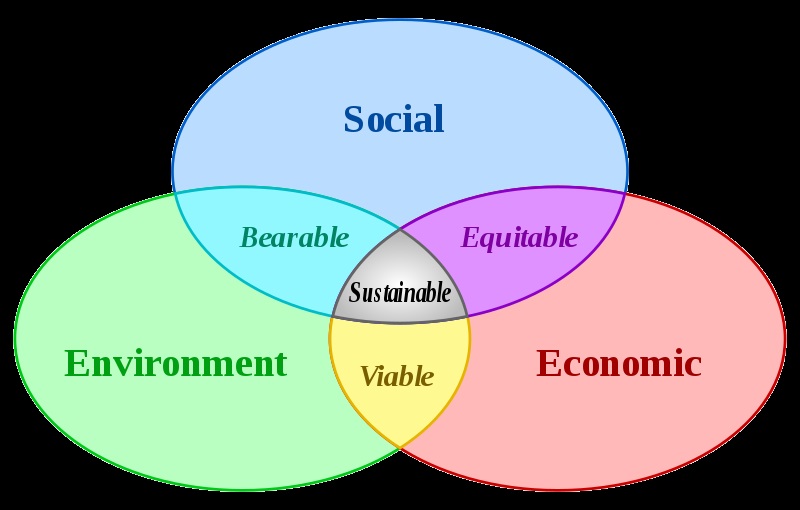Social sustainability

|
| The tripartite representation of sustainable development. Source: Wikimedia Commons |
Contents |
[edit] Introduction
Sustainability can be thought of as comprising three major components:
- Environmental (biophysical) sustainability
- Economic sustainability
- Social sustainability
The first is probably the one that most people think of when approaching sustainability. However, although all three are core components of sustainable development, it is social sustainability which seems to receive far less attention in public discourse.
There is a school of thought that rejects the tripartite classification illustrated above because it claims that all forms of sustainability have a social dimension, including ecological, economic, political and cultural sustainability. Clearly, there are several approaches in arriving at a definition of social sustainability.
Social Life, a UK-based social enterprise specialising in place-based innovation, defines social sustainability as:
“A process for creating sustainable, successful places that promote wellbeing, by understanding what people need from the places they live and work. Social sustainability combines design of the physical realm with design of the social world – infrastructure to support social and cultural life, social amenities, systems for citizen engagement, and space for people and places to evolve.”
In addition, the processes and structures developed to achieve social sustainability should meet the needs of current communities without adversely affecting the ability of future communities to meet their needs and to create thriving, healthy communities.
Elements of social sustainability can include:
- Living conditions
- Health
- Safety
- Social justice
- Social capital
- Wellness
- Community development
- Community resilience
- Diversity
- Equity
- Social support
- Fair labour practices
- Empowerment
- Work-life balance
- Community engagement
- Philanthropy,
[edit] Business
Social sustainability should be a critical part of any business, claims the UN Global Compact, because it affects the quality of a business’ relationships with stakeholders. Social sustainability is a proactive way of managing and identifying business impacts on employees, workers in the value chain, customers and local communities.
A firm’s social license to operate can depend on its efforts to achieve greater social sustainability. Companies that embrace social sustainability as part of their core business strategy tend to be cognisant of the fact that their relationships with people, communities and society are critically important. For example, a socially sustainable business will be mindful of the safety of its workforce on its premises and will ensure that both it and its employees comply with all health and safety regulations.
In contrast, a firm that oversees a system of poor social sustainability increases the risks to its brand and product quality. Consumers and the media are not generally happy when they uncover stories of workers in appalling or unsafe conditions, or being paid starvation wages. All these can damage a corporation’s brand.
Increasingly educated consumers tend to like transparent supply chains and may spend more on ‘ethical’ products that have traceable supply networks and lower environmental impacts.
[edit] Towards more socially sustainable communities
Achieving greater social sustainability can, according to the UN Global Compact, help businesses to:
- Unlock new markets.
- Improve risk management.
- Become a source of innovation for new product/service lines.
- Help attract and retain business partners.
- Raise internal morale and employee engagement.
- Improve company-community conflicts.
[edit] Related articles on Designing Buildings Wiki
- A new deal for social housing.
- Affordable housing.
- Affordable rented housing.
- Cohousing.
- Creating social value from civil engineering projects.
- Creating strong communities – measuring social sustainability in new housing development
- Gentrification.
- Help to buy.
- Housing associations.
- Housing tenure.
- Intermediate housing.
- Municipal Dreams: the rise and fall of council housing.
- Private-rented sector regulations.
- Public v private sector housing.
- Regeneration.
- Right to acquire.
- Right to buy.
- Right to rent.
- Shared equity / Partnership mortgage.
- Shared ownership.
- Social housing v affordable housing.
- Social rented housing.
- Social value act
- The full cost of poor housing.
- Town and Country Planning Act.
Featured articles and news
Architects, architecture, buildings, and inspiration in film
The close ties between makers and the movies, with our long list of suggested viewing.
SELECT three-point plan for action issued to MSPs
Call for Scottish regulation, green skills and recognition of electrotechnical industry as part of a manifesto for Scottish Parliamentary elections.
UCEM becomes the University of the Built Environment
Major milestone in its 106-year history, follows recent merger with London School of Architecture (LSE).
Professional practical experience for Architects in training
The long process to transform the nature of education and professional practical experience in the Architecture profession following recent reports.
A people-first approach to retrofit
Moving away from the destructive paradigm of fabric-first.
International Electrician Day, 10 June 2025
Celebrating the role of electrical engineers from André-Marie Amperè, today and for the future.
New guide for clients launched at Houses of Parliament
'There has never been a more important time for clients to step up and ...ask the right questions'
The impact of recycled slate tiles
Innovation across the decades.
EPC changes for existing buildings
Changes and their context as the new RdSAP methodology comes into use from 15 June.
Skills England publishes Sector skills needs assessments
Priority areas relating to the built environment highlighted and described in brief.
BSRIA HVAC Market Watch - May 2025 Edition
Heat Pump Market Outlook: Policy, Performance & Refrigerant Trends for 2025–2028.
Committing to EDI in construction with CIOB
Built Environment professional bodies deepen commitment to EDI with two new signatories: CIAT and CICES.
Government Grenfell progress report at a glance
Line by line recomendation overview, with links to more details.
An engaging and lively review of his professional life.
Sustainable heating for listed buildings
A problem that needs to be approached intelligently.
50th Golden anniversary ECA Edmundson apprentice award
Deadline for entries has been extended to Friday 27 June, so don't miss out!
CIAT at the London Festival of Architecture
Designing for Everyone: Breaking Barriers in Inclusive Architecture.
Mixed reactions to apprenticeship and skills reform 2025
A 'welcome shift' for some and a 'backwards step' for others.
























